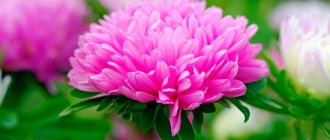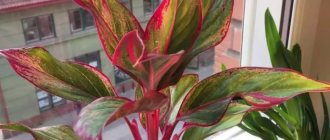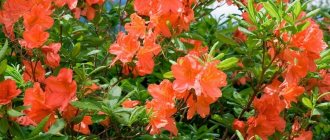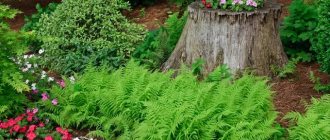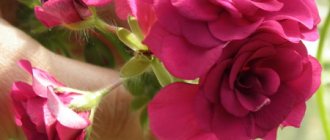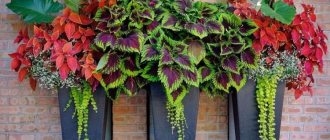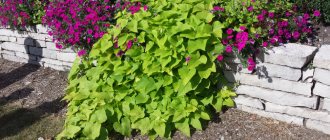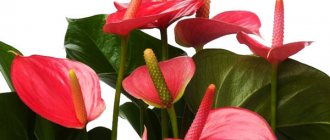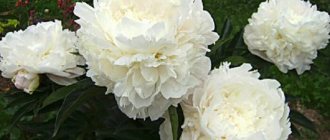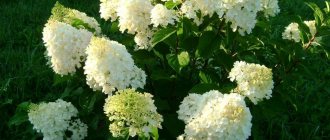Frost-resistant varieties of rhododendrons - a selection of the best varieties with descriptions and photos
The majesty and nobility of rhododendrons has been known since ancient times. Luxurious bushes perfectly decorate the garden and add zest to its appearance. But when choosing a variety to grow in your own garden, you need to determine its frost resistance. Thanks to the enormous selection and availability of hybrids, the gardener has the opportunity to give preference to a variety that corresponds to the climatic characteristics of the region. Types of rhododendrons (pictured below) are also selected according to the individual capabilities of the gardener.
PJM Elite
Rhododendron with the mysterious name PZhM Elite is a small-leaved evergreen hybrid of Carolina rhododendron and Daurian rhododendron of the sempervirens form (Ledum).
This shrub is quite compact, blooms luxuriantly, and tolerates frosts down to –32°C.
The flowers of the rhododendron PZhM Elite are raspberry-pink, cone-shaped, collected in brushes of 4-9 pieces.
Flowering time Bush height (cm) Bush width (cm) Distance between bushes (cm) Features May 150-180 150-180 150-180Variety of species
When choosing varieties, a gardener should understand what frost resistance is. Professionals define frost resistance by the ability of a plant to tolerate all the factors of winter: frost, wind, snowfall, icing, thaws.
The components of frost resistance are:
- The ability of plants to withstand early frosts, which are very common in autumn, without shelter.
- The maximum indicators at which the plant can tolerate low temperatures.
- Painless withstanding of a thaw, during which awakening is observed, with further freezing.
- Resistance to damping off of the root system under a warm shelter or snow cover.
The varietal selection includes more than 20 varieties of flowering shrubs that survive the winter well. All rhododendrons, the varieties of which are grown regardless of the climatic characteristics of the region, are divided into:
- Deciduous, which shed their green crown cover in autumn.
- Evergreens that do not stop developing even in extreme cold.
- Semi-evergreen with a dormant period.
- Hybrid, resulting from crossing different varieties.
Roseum Elegans
Roseum Elegance is a variety of Katevbinsky rhododendron.
This shrub is valued not only for its winter hardiness, but also for its magnificent clusters of inflorescences, each of which consists of 10-20 pinkish-lavender flowers with delicate “curly” petals.
Rhododendron Roseum Elegans is a tall, stately beauty that attracts many bees and butterflies.
Flowering time Bush height (cm) Bush width (cm) Distance between bushes (cm) Features May-June 180-240 180-240 180-240 Tolerates heat wellFrost-resistant varieties of rhododendrons with photos
- Evergreen shrubs - Smirnova (the bush grows up to 1.5 meters, blooms with pink buds with yellow dots in mid-April, frost resistance - 30 degrees), Short-fruited (bush up to 2.5 meters high with white flowers, frost resistance -25 degrees), Zolotisny ( A variety for Siberia that can easily survive frosts of more than 40 degrees. It blooms with white inflorescences-umbrellas), Katevbinsky (a shrub up to 1.5 m high with purple blooms.).
- Deciduous varieties - Canadian (spherical bush measuring 1x1 m. Natural habitat - North America), Kamchatka (low-growing bush 40-50 cm high. Rich red inflorescences appear in late spring), Caucasian (outwardly similar to a branched tree up to 4- x meters. Blooms in May with small yellow inflorescences), Japanese, Schlippenbach, Pukhkansky, Vazeya.
The most frost-resistant rhododendrons, which can withstand frosts of more than 30 degrees, are Katevbinsky, Helliki, Kamchatka, Zhelty, Karolinsky. The varieties Bluretti, Bershtein, and Molton Gold can withstand minor frosts.
Professionals recommend growing varieties of rhododendrons that have undergone a period of acclimatization in a certain climatic zone. When buying planting material of foreign selection, you should be extremely careful, remembering that winters in Europe are much milder, which means the shrub will be more vulnerable to frost and icy winds.
Rosy Lights
Rhododendron Rosie Lights is a deciduous azalea. Its winter hardiness is amazing - it overwinters even at -42°C!
This shrub will be an excellent decoration for any garden. In late spring and early summer, it is strewn with lush clusters of bright pink flowers speckled with pinkish-orange. The leaves change color from olive to dark burgundy in the fall.
Flowering time Bush height (cm) Bush width (cm) Distance between bushes (cm) Features May-June 120-180 120-180 120-180Varieties for different climate zones
The rhododendron plant, the description of which provides an opportunity to study the characteristics of domestic selection, can be cultivated in all regions of the country. Professional gardeners recommend planting group flower beds with an early flowering period.
Any varieties that are resistant to diseases and pests are suitable for average climatic regions. You can choose varieties of American selection that can withstand heat and frost. Aurora, Laika, Dagmar - representatives of the Smirnova variety are grown throughout the country. The varieties Album Novum and Lumina are characterized as frost-resistant, but in places where the winter has little snow and cold, they require shelter during the cold period.
In urban growing conditions, preference is given to varieties Mandarin Lights, Lemon Lights, Golden Ligths and hybrids Feuerwerk and Fireball, Cecile, Golden Sunset, Persil, Oxydol.
White Lights
White Lights is one of the varieties of deciduous azalea. This rhododendron can withstand frosts from -34°C to -42°C! So you can safely plant it in the middle zone and forget about winter shelter.
In May, the pink buds turn into large pinkish-pearl flowers with small golden splashes. Over time, the petals turn white. In autumn the foliage takes on a dark bronze hue.
Flowering dates Bush height (cm) Bush width (cm) Distance between bushes (cm) Features May-June 120-150 120-150 120-150 Are there other winter-hardy rhododendrons growing in your garden? Share the names of varieties in the comments to this article or on our forum!Winter-hardy varieties
Frost-resistant rhododendrons are very popular among beginners, because they only require shelter for the winter period and tolerate not only low temperatures, but also sudden changes.
Deciduous hybrids Ghent, Weston, Exbury winter well at 20-29 degrees below zero. The deciduous group Northern Light with pink flowering tolerates temperatures of minus 35 degrees. Spicy Lights and Golden Lights are grown at 35-39 degrees, and Rosy Lights, Pink Lights and Orhid Lights are grown at 42 degrees below zero.
Rhododendron is evergreen, varieties of which can be grown in regions with harsh winters:
Marcel Menard is a shrub with purple flowers in spring. Frost resistance up to 24 degrees.
Brazil is a shrub up to 1.5 m high with rich green leaf blades and orange-yellow flowers. Excellent winter hardiness at -25 degrees.
Erato is a bush up to 1.5 m high with bright red flowers. Frost resistance – 26-28 degrees.
Lita is a plant up to 2.5 m high with wide dark green leaf blades and purple-pink buds. At a frost of 35 degrees it develops stably.
Alfred is a compact shrub about 1 m high. Large purple-red buds adorn the plant in late spring or early summer. It survives short-term frosts down to -26.
Libretto is a winter-hardy shrub slightly more than 1 m high. It blooms with crimson-violet flowers in spring. Withstands frosts up to 26 degrees.
For successful cultivation, you should not only choose a frost-resistant variety, but also provide it with proper care:
- Determining the time of planting a seedling. Instances with an open root system are planted in a permanent place in March. Container plants can be replanted at any time during the active growing season.
- Rhododendron is a water-drinker and this must be remembered. 20 liters of soft water are poured under an adult bush.
- Adding nutrients. They use only special complexes for rhododendrons, which can be bought at the garden center.
- Mulching the soil surface and covering for the winter.
The winter hardiness of varieties is also affected by the composition of the soil - rhododendrons are planted only in acidic soils. You should not plant seedlings in open areas: evergreen and deciduous varieties are equally afraid of drafts and strong gusts of wind. Varieties that do not shed leaves are cultivated in partial shade; deciduous varieties require diffused light.
By choosing a suitable variety and providing it with proper care, you can get flowering already in the 2-3rd year of cultivation. Many gardeners deny themselves the pleasure of growing rhododendrons, considering them capricious plants. They do require some knowledge and a little attention. But they thank you for your care with gorgeous blooms of various colors.
Mount Saint Helens
This deciduous azalea is notable for its unprecedented frost resistance - it tolerates temperatures down to -32°C.
Another distinctive feature of the Mount St. Helens rhododendron is the unusual color of the flowers. Their petals are a delicate salmon-pink shade with golden tangerine spots. Elegant bell-shaped flowers are collected in brushes of 11 pieces. The dark green, glossy leaves of the shrub take on a rich bronze hue in autumn.
| Flowering time | Bush height (cm) | Bush width (cm) | Distance between bushes (cm) | Peculiarities |
| May June | 20-50 | 20-50 | 20-50 | Slowly growing |
| Flowering time | Bush height (cm) | Bush width (cm) | Distance between bushes (cm) | Peculiarities |
| May June | 90-180 | 90-180 | 90-180 | Strong aroma, suitable for creating hedges |
| Flowering time | Bush height (cm) | Bush width (cm) | Distance between bushes (cm) | Peculiarities |
| May June | 180-240 | 180-240 | 180-240 | Suitable for creating hedges and mixborders |
| Flowering time | Bush height (cm) | Bush width (cm) | Distance between bushes (cm) | Peculiarities |
| May June | 90-150 | 90-150 | 90-150 | Strong aroma |
| Flowering time | Bush height (cm) | Bush width (cm) | Distance between bushes (cm) | Peculiarities |
| May June | 150-180 | 150-180 | 150-180 | Suitable for creating hedges and mixborders |
The best varieties of rhododendrons for growing in the Moscow region
Rhododendron is a luxurious decoration for a garden plot. Flower growers love these plants no less than roses and peonies, but are often afraid to grow them, since there is an opinion that rhododendrons are heat-loving and cannot tolerate winters near Moscow. However, many varieties of rhododendrons winter well in the Moscow region in open ground conditions. Winter-hardy varieties do not freeze, are not afraid of pests and diseases, and tolerate slight shading. Among them there are shrubs with inflorescences of various colors and sizes, with a pronounced and subtle aroma. Caring for them is available to everyone.
Instead of an afterword
Of course, it’s not so easy to grow beautiful exotic plants on your plot. The best rhododendrons for the Moscow region are those that are frost-resistant. They take root well in our latitudes, but require careful care. By following all the rules and recommendations, you can get a beautiful, profusely flowering plant that will delight you for many years. Although growing rhododendrons in the Moscow region is associated with some difficulties, the result is worth it; a year after planting the exotic on the site, it will please you with its first flowering, the abundance of which will depend on your care.
Types for the Moscow region
The range of rhododendrons for the middle zone is quite large. Central Russia is suitable for approximately 40 species of these plants.
Any gardener who wants to decorate a plot in the Moscow region with rhododendrons has the opportunity to satisfy their needs. Evergreen, semi-evergreen and deciduous species can be grown in this climate.
- Evergreens: Katevbinsky, Smirnova, Short-fruited, Largest, Golden.
- Semi-evergreens: Lemura, Sikhotinsky.
- Deciduous: Japanese, Yellow, Canadian, Kamchatka, Pukhansky.
Varieties of species rhododendrons
Varietal rhododendrons first appeared in Russia in 1994, when 18 varieties were brought from Germany to the country's Main Botanical Garden. All plants took root, grew well and bloomed in the new conditions. Based on this experience, botanical garden specialists recommend the following cultivars to lovers:
- Annemarie - bush height up to 50 cm, diameter up to 60 cm. The leaves are small, covered with snow in the fall. The color of the plates is dark green and gray-green. In Moscow it blooms from mid-summer to the end of October. The most abundant flowering occurs in September. The flowers are double, the length of the inflorescence is up to 20 cm. The buds are purple in color, the flowers are dark pink.
- Allegro is an evergreen plant up to 50 cm high, up to 50 cm in diameter. The leaf blades are dark. Blooms profusely from early August to early October. The flowers are double, bright red, collected in inflorescences up to 30 cm long.
- Long White is a tall variety, plant height up to 70 cm. The bush is spherical, the leaves are small and bright. The flowers are snow-white, non-double, arranged in racemes up to 30 cm long. This variety blooms from late summer to November, so it is suitable for creating winter bouquets.
- Boskop is a ground cover rhododendron up to 40 cm high with spectacular green and orange-red leaves. The flowers are single, the inflorescence length is up to 10 cm. The color of the petals is light lilac. The variety blooms from late summer to November.
- Silver Knight is a cushion-shaped plant up to 30 cm high, up to 40 cm in diameter. The leaves are light gray, turning purple in autumn. The flowers are lilac, non-double, with red stamens that stand out brightly against the background of the petals. It blooms from August to mid-autumn, sometimes until the first snow.
Most varieties of European selection with red flowers turned out to be unsuitable for cultivation in the Moscow region, since they were bred using a heat-loving species - the Himalayan tree rhododendron.
Plants from Finland
In Finland, varieties based on short-fruited rhododendron have been bred. All of them are very promising for the Moscow region.
Table: varieties of Finnish selection:
Name
Description
Bush height 1 m, flower color white
Bush height 0.6 m, flower color red
Bush height 2.0 m, dark pink flowers, blooms in mid-June
Bush height 1.5 m, pink-purple flowers
Bush height 2.0 m, white flowers
Bush height 1.0 m, flowers white and pink
Bush height 2.0 m, white flowers
Promising interspecific hybrids
In addition to species plants, there are interspecific hybrids. They are particularly frost-resistant and resilient. Thus, hybrids bred with the participation of Smirnov and Caucasian rhododendron can withstand frosts down to minus 26. The height of the plants reaches a height of 1 m. The most common:
Hybrids of Katevbinsky rhododendron are the most cold-resistant, withstanding frosts down to minus 32. All of them bloom in early summer with red, purple, lilac or white flowers. Popular varieties:
- Alfred;
- Burso;
- Catawbens Grandiflomm;
- Abraham Lincoln;
- New land;
- Roseum Elegance.
Of the deciduous rhododendrons, the hybrids from the Northern Lights group, bred in the middle of the last century in Minnesota (USA), are distinguished by the greatest frost resistance. The plants can withstand frosts down to minus 42. Rhododendrons Costerianum and Prinophyllum were involved in their breeding.
- Rosie Lights;
- Pink Lights;
- Golden Lights;
- Orchid Lights;
- Spicy Lights;
- Mandarin Lights;
- Nozem Hi Lights;
- Three lights.
Short-fruited varieties
Short-fruited varieties tolerate temperature drops to -34°C and below. The following varieties belong to this type:
- 1 Rhododendron “Helliki”. Rhododendron Helliki is a variety of evergreen, winter-hardy azaleas. This is a Finnish hybrid. It reaches a height of 120 cm. Purple-red flowers create an inflorescence at the end of the branch of 8-12 pieces. Flowering begins in mid-June. Frost-resistant. Withstands temperatures of -34°C. It is recommended to plant in loose, acidic, well-drained soil. Loves dark places, protected from draft winds. Needs protective measures from the spring sun. Mulching is necessary annually. The soil in the root zone should not be too wet or dry.
- 2 Rhododendron “PMA Tigerstedt”. Tigerstedt is an evergreen hybrid. Reaches a height of about 2 meters. Loves bright places where it grows into a wide and tall bush. The inflorescences contain up to 18 cream-colored flowers; the upper petal may have dark purple spots. Flowers are about 7 cm in diameter. Can grow in partial shade.
- 3 Rhododendron “Saint Michel”. This is an evergreen, winter-hardy rhododendron hybrid. Reaching ten years of age, it becomes a two-meter shrub. Older gets even taller. The inflorescences bear from 10 to 18 soft pink flowers with a diameter of about 8 cm. The edges of the petals are double. Blooms in June.
- 4 Rhododendron “Helsinki University”. It is also a hybrid of Finnish origin. Evergreen, frost-resistant plant. At the age of 10 years, it measures about 1x1 m. As it gets older, it stretches up to two meters. This variety is distinguished by abundant flowering after very harsh winters. The flowers are 7-8 cm in diameter, pink with red spots on the inside of the petals. It blooms in the south of Finland in June, in the north - later. It blooms simultaneously with the growth of young shoots. Withstands temperatures of -32…-39°C. Loves partial shade, acidic soil, which is capable of good ventilation and moisture-absorbing. Mulching is recommended for this variety. The root system is on the surface, so constant watering is necessary, especially in hot weather. It is better to create protection for the rhizome.
The Faurie rhododendron variety has less frost resistance: from -23 to -29°C. Rhododendron variety Fori is frost-resistant. Tolerates temperatures down to -29°C. Fory is distributed throughout the Russian Far East. This is the largest species of rhododendron. You could say it's a small tree. It reaches a height of 5 m. Evergreen long-liver. The inflorescence is a raceme, which includes from 10 to 15 buds. The flowers are quite large and are either pink or white. Blooms in June-July. In addition, the Fori species includes varieties such as Brazil, Gabriel, Laika. It is better to cover plants for the winter.
Growing
Growing rhododendrons is no more difficult than barberry or honeysuckle. Unpretentious species plants can be grown even by beginners. For successful cultivation, you must follow simple rules:
- The planting site is chosen in partial shade;
- the soil should be acidic, with a high content of humus;
- there should be no substances that alkalize the soil near the roots - wood ash, lime, dolomite flour;
- It is necessary to mulch the plantings, preferably with pine needles or pine bark.
The roots of rhododendrons are located superficially, so the soil under the bushes cannot be loosened or dug up. Plants love water very much. They have to be watered frequently to prevent the coma from drying out.
Landing
Rhododendrons have compact roots, so they don't need a large planting hole. It is enough to prepare a depression up to half a meter deep. The width of the pit depends on the type of rhododendron. For large plants (Yellow River or Katevbinsky River), the diameter of the hole should be 0.8 m. When planting on heavy soils, be sure to fill the bottom of the hole with a drainage layer of about 15 cm.
The most important stage in planting rhododendrons is preparing the substrate with which the planting hole will be filled. The ideal mixture is made up of:
- three shares of leaf soil;
- two shares of high peat;
- one share of needles.
A substrate composed only of high-moor peat and pine or spruce needles in equal parts is allowed. Low-lying peat is unsuitable for planting rhododendrons - it has a fine structure, so the soil will float.
The soil, which includes pine needles and peat, has the acidity necessary for rhododendrons, does not caking and provides the plants with all the necessary substances.
- seedlings with a closed root system are immersed in water and kept until air bubbles stop coming out of the ground.
- the bush is taken out of the container and planted in a hole filled with substrate to the same depth;
- Water abundantly and sprinkle with mulch.
After planting, you need to make sure that the root collar of the plant is not covered with soil. Rhododendrons planted too deeply die quickly.
Mulching is a mandatory technique when growing this crop. Pine needles, moss, dry oak leaves or peat are suitable for this. Maple and chestnut leaves should not be used as mulch, as they alkalize the soil. Mulch protects the rhododendron roots, which are located very close to the soil surface, from overheating, drying out, and in winter from freezing. The layer of mulch under the plants should be at least 5 cm.
Choosing a winter-hardy variety
Those azaleas (azaleas) that we grow at home on windowsills are not intended for outdoor wintering in the middle zone. But at gardening markets they are selling a variety of outdoor varieties of rhododendrons that are capable of abundant flowering from spring to mid-summer. An azalea flower of lilac or pink color is always pleasing to the eye.
Pay attention to deciduous azaleas - they are quite winter-hardy. Of the evergreen plants in our gardens, you can plant and successfully grow those that live well and have a beautiful appearance:
- Rhododendron Katevbinsky (this is the name of a group of tall and fairly winter-hardy plants), varieties: “Fastozum Flore Plena”, “Alfred”, “Biber”, “Hesse”, “Ligo”, “Roseum Elegance”;
- Rhododendron Blushing (low-growing varieties): “Violetta”, “Azourvolke”;
- Rhododendron Kamchatka;
- Rhododendron Ledebur;
- Dense rhododendron, varieties “Azurika” and “Bloomiria”;
- Rhododendron Smirnova, varieties “Delila” and “Ligava”.
If you are offered other varieties on the market, then ask about their species name. Do not buy a flowering plant with a large leaf as a planting material - it is intended for indoor cultivation, this is not a garden variety!
The most resistant varieties for the garden are bred from rhododendrons Katevbinsky, Ledebur, Krasneuchey, Plotny, Smirnov.
Peculiarities
The main disadvantage of growing rhododendrons is their poor adaptation to the soil. Therefore, if the soil on the site is not acidic enough, the plant will get sick and wither. To prevent this from happening, the gardener himself has to adapt to the requirements of this shrub.
Also, due to improper agricultural practices, seedlings may get sick, and lush flowering will not appear on the branches soon. Therefore, it is very important to carry out preventive measures to prevent the appearance of spider mites, chlorosis and fungal diseases.
The advantage of rhododendrons is their abundant flowering. Even branches cut for a bouquet will last a long time in a vase and delight you with their beauty. Rhododendron can be used in garden compositions and as a single garden decoration. A lush bush can cover unattractive areas in the garden, becoming a kind of green screen.
Rhododendron, brought from East Asia to Europe more than 160 years ago by Robert Fortune, gained great popularity in the Moscow region. By following simple planting and care basics, you can easily grow this foreign miracle flower in any area. Despite its foreign origin, this bush takes root well even on lands unfamiliar to it.
Preparing the site
Most types of azaleas and rhododendrons can be grown successfully if the planting site meets the following important requirements:
- it can provide good drainage for plants;
- the place is in partial shade or has the necessary protection from direct sunlight;
- the soil on the site is light or you are able to prepare large planting holes with a complete replacement of the soil in them;
- you can equip an irrigation system or ensure regular watering of the plants; azalea appreciates moisture.
The best areas for growing rhododendrons are shaded, wooded areas, slightly elevated on the terrain. Therefore, the snow melts off them early and does not stagnate; and they are protected from the winds.
Holes for planting should be made three times wider and 2 - 3 times deeper than the lump of earth or container in which you bought the azalea. The soil in the hole should be completely replaced with a mixture of two parts of well-rotted, odorless, light brown humus (using fresh manure or under-rotted humus will lead to the rapid death of the seedling!), two parts of acidic peat and one part of coarse sand. It is also good to add to the soil up to 1/5 of the coniferous litter collected in the forest or finely ground pine bark, which can be bought at gardening markets.
How to plant?
Preparing the site and soil
Rhododendrons do not like wind or direct sunlight. They can be planted on the northern or northeastern side of the site, but it is very good if the walls of buildings cover the plantings on the southern and western sides. It is important to prevent snow from falling on the plants from the roof.
Apple, pear, cherry, larch, and pine trees can be good neighbors for rhododendrons, in the shade of which they will feel at home. In the place where rhododendrons grow, there should be no stagnation of water or nearby groundwater. As for the soil, it has already been mentioned that these plants love acidic, nutrient-rich soil with good drainage.
Before planting, it is recommended to prepare a mixture of the following composition: red peat, loam and pine needles in a ratio of 2:3:1. Then determine its pH. An indicator from 4.5 to 5.5 is considered good. If it is higher, then the mixture must be acidified. To do this, you can add an additional portion of high-moor peat, sulfuric acid fertilizers or superphosphates. There is also a special soil for rhododendrons on sale.
Rules and terms of planting in the Moscow region
You can plant rhododendrons at any time, except when the plant is blooming, but it is best to do this in the spring. This procedure is carried out as follows:
- A hole measuring 60x60 cm and depth 40 cm is dug. For seedlings with an undeveloped root system, the size can be reduced to 40x40x30.
- A layer of drainage, such as sand, is placed at the bottom.
- The bulk of the remaining space is filled with earthen mixture.
- A hole is dug and the seedling is carefully placed into it. Its roots must be pre-soaked with water to eliminate the possibility of damage during the obligatory straightening of the roots. You also need to check whether a crust has formed from old dead roots. It needs to be removed.
- The mixture is topped up and compacted. The base of the root should not be buried in the ground.
- Watering is carried out (it is advisable to slightly acidify the water with vinegar) and the tree trunk circle is mulched with pine needles, peat or oak leaves.
- If necessary, temporary support is installed.
Video instructions on how to plant rhododendron:
Planting and care
In early spring (this is the best time to plant a plant), the prepared mixture for the pit is thoroughly mixed, and a specialized fertilizer for rhododendrons is added to it. As a last resort, you can simply add a complete complex organic-mineral fertilizer.
A drainage made of broken brick or granite (attention, granite!) crushed stone is placed at the bottom of the pit. The thickness of the drainage layer is 15 – 20 cm.
When planting, pay attention to the location of the root: the root neck of the rhododendron cannot be buried - the plant will bloom poorly or even die.
The easiest way to feed is with specialized acidic fertilizers for rhododendrons. In the first two years, the plant does not need feeding; after that, chlorine-containing fertilizers should not be used; mullein or any manure in general should not be used.
Azaleas for a garden in the Moscow region really appreciate abundant watering once a month with sour water infused with ordinary lemons. The infusion is made like this: squeeze five lemons into 5 liters of water.
Squeezed lemons are also thrown into water and left for 5 - 6 hours. Next, 2.5 liters of this water are poured under one large rhododendron bush or 1.5 liters under a small one (up to 1 m in height).
Deciduous azaleas tolerate winters well with the climate typical for central Russia.
With proper care, the plant will grow well and should bloom in 3-4 years.
FORUMHOUSE has collected a lot of useful information on rhododendrons, you can ask for advice, study the experience of our best gardeners, look at photographs, etc.
Plant pruning
Does rhododendron need pruning? As a rule, the plant grows evenly and forms a lush bush of regular shape with flowers. If you are a supporter of voluminous plants, then you shouldn’t even think about pruning. However, periodically the bush needs to be thinned out or rejuvenated. In such cases, pruning is done in early spring; you need to have time to do this before the sap begins to flow. Strong shoots are trimmed, and the cut points are treated with resin or garden pitch. In a month, you will notice that the renewal process has begun: sleeping buds will wake up and young branches will begin to grow.
Even the best varieties of rhododendrons are characterized by uneven flowering. If this year the plant pleased you with lush flowering, then you probably shouldn’t expect the same number of flowers next year. In order to partially influence this situation, you can remove all buds from the bush immediately after flowering. This simple method will allow the plant to retain its strength and direct it to enhanced bud formation for the next year.

